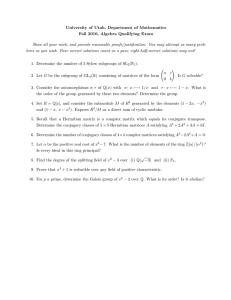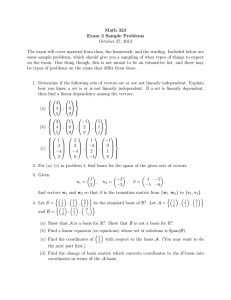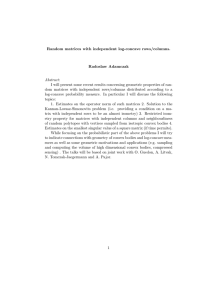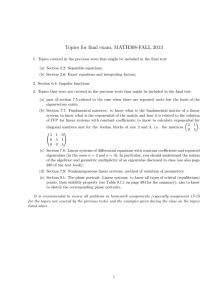Extreme points of the set of density matrices with positive... J. M. Leinaas J. Myrheim
advertisement
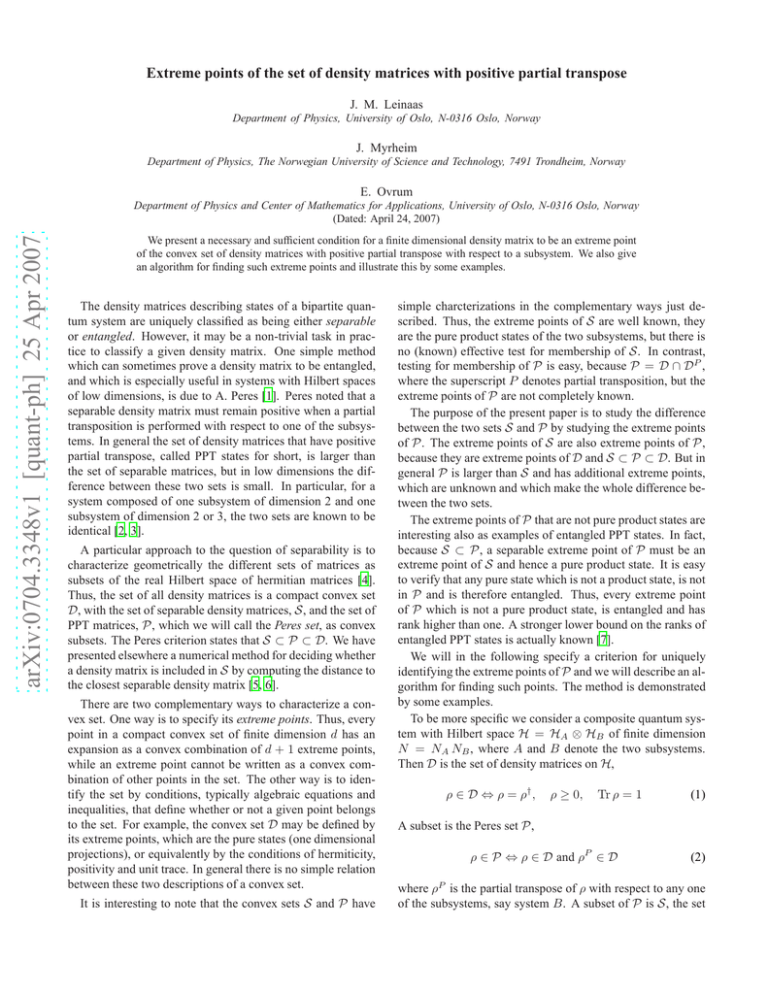
Extreme points of the set of density matrices with positive partial transpose
J. M. Leinaas
Department of Physics, University of Oslo, N-0316 Oslo, Norway
J. Myrheim
Department of Physics, The Norwegian University of Science and Technology, 7491 Trondheim, Norway
E. Ovrum
arXiv:0704.3348v1 [quant-ph] 25 Apr 2007
Department of Physics and Center of Mathematics for Applications, University of Oslo, N-0316 Oslo, Norway
(Dated: April 24, 2007)
We present a necessary and sufficient condition for a finite dimensional density matrix to be an extreme point
of the convex set of density matrices with positive partial transpose with respect to a subsystem. We also give
an algorithm for finding such extreme points and illustrate this by some examples.
The density matrices describing states of a bipartite quantum system are uniquely classified as being either separable
or entangled. However, it may be a non-trivial task in practice to classify a given density matrix. One simple method
which can sometimes prove a density matrix to be entangled,
and which is especially useful in systems with Hilbert spaces
of low dimensions, is due to A. Peres [1]. Peres noted that a
separable density matrix must remain positive when a partial
transposition is performed with respect to one of the subsystems. In general the set of density matrices that have positive
partial transpose, called PPT states for short, is larger than
the set of separable matrices, but in low dimensions the difference between these two sets is small. In particular, for a
system composed of one subsystem of dimension 2 and one
subsystem of dimension 2 or 3, the two sets are known to be
identical [2, 3].
A particular approach to the question of separability is to
characterize geometrically the different sets of matrices as
subsets of the real Hilbert space of hermitian matrices [4].
Thus, the set of all density matrices is a compact convex set
D, with the set of separable density matrices, S, and the set of
PPT matrices, P, which we will call the Peres set, as convex
subsets. The Peres criterion states that S ⊂ P ⊂ D. We have
presented elsewhere a numerical method for deciding whether
a density matrix is included in S by computing the distance to
the closest separable density matrix [5, 6].
There are two complementary ways to characterize a convex set. One way is to specify its extreme points. Thus, every
point in a compact convex set of finite dimension d has an
expansion as a convex combination of d + 1 extreme points,
while an extreme point cannot be written as a convex combination of other points in the set. The other way is to identify the set by conditions, typically algebraic equations and
inequalities, that define whether or not a given point belongs
to the set. For example, the convex set D may be defined by
its extreme points, which are the pure states (one dimensional
projections), or equivalently by the conditions of hermiticity,
positivity and unit trace. In general there is no simple relation
between these two descriptions of a convex set.
It is interesting to note that the convex sets S and P have
simple charcterizations in the complementary ways just described. Thus, the extreme points of S are well known, they
are the pure product states of the two subsystems, but there is
no (known) effective test for membership of S. In contrast,
testing for membership of P is easy, because P = D ∩ DP ,
where the superscript P denotes partial transposition, but the
extreme points of P are not completely known.
The purpose of the present paper is to study the difference
between the two sets S and P by studying the extreme points
of P. The extreme points of S are also extreme points of P,
because they are extreme points of D and S ⊂ P ⊂ D. But in
general P is larger than S and has additional extreme points,
which are unknown and which make the whole difference between the two sets.
The extreme points of P that are not pure product states are
interesting also as examples of entangled PPT states. In fact,
because S ⊂ P, a separable extreme point of P must be an
extreme point of S and hence a pure product state. It is easy
to verify that any pure state which is not a product state, is not
in P and is therefore entangled. Thus, every extreme point
of P which is not a pure product state, is entangled and has
rank higher than one. A stronger lower bound on the ranks of
entangled PPT states is actually known [7].
We will in the following specify a criterion for uniquely
identifying the extreme points of P and we will describe an algorithm for finding such points. The method is demonstrated
by some examples.
To be more specific we consider a composite quantum system with Hilbert space H = HA ⊗ HB of finite dimension
N = NA NB , where A and B denote the two subsystems.
Then D is the set of density matrices on H,
ρ ∈ D ⇔ ρ = ρ† ,
ρ ≥ 0,
Tr ρ = 1
(1)
A subset is the Peres set P,
ρ ∈ P ⇔ ρ ∈ D and ρP ∈ D
(2)
where ρP is the partial transpose of ρ with respect to any one
of the subsystems, say system B. A subset of P is S, the set
2
of separable density matrices,
X
B
ρ∈S⇔ρ=
p k ρA
k ⊗ ρk ,
pk > 0,
k
X
projection P1 in the same way as we defined P from ρ in (5).
If we can find a hermitian matrix σ solving the equation
pk = 1 (3)
k
Thus, S is the convex hull of the product states of the two
subsystems, and its extreme points are the pure product states.
To develop the method we need for finding the extreme
points of P we will first apply it to D, the full set of density
matrices, with the pure states as extreme points. We recall
some definitions and elementary facts.
Every ρ ∈ D is hermitian and has a spectral decomposition
X
λi |ψi ihψi |
(4)
ρ=
i
with real eigenvalues λi and orthonormal eigenvectors |ψi i.
The positivity condition ρ ≥ 0 means that all λi ≥ 0, or
equivalently that hψ|ρ|ψi ≥ 0 for all |ψi, with hψ|ρ|ψi = 0 if
and only if ρ|ψi = 0. The orthogonal projection
X
(5)
P =
|ψi ihψi |
i,λi >0
projects onto the image (or range) of ρ, whereas 1−P projects
onto the kernel of ρ, denoted by ker ρ.
If ρ is not an extreme point of D it is a convex combination
ρ = xρ′ + (1 − x)ρ′′ ,
0<x<1
(6)
with ρ′ , ρ′′ ∈ D and ρ′ 6= ρ′′ . The identity
hψ|ρ|ψi = x hψ|ρ′ |ψi + (1 − x) hψ|ρ′′ |ψi
(7)
shows that ρ ≥ 0 when ρ′ ≥ 0 and ρ′′ ≥ 0, thus proving the
convexity of D. More interestingly, it shows that
ker ρ = ker ρ′ ∩ ker ρ′′
(8)
With P defined as in (5) we have therefore P ρP = ρ, P ρ′ P =
ρ′ , and P ρ′′ P = ρ′′ .
When (6) holds, the matrix σ = ρ′ − ρ is hermitian and
nonzero, and Tr σ = 0, hence σ has both positive and negative
eigenvalues. Moreover, P σP = σ. Define
τ (x) = ρ + xσ
(9)
for x real. Since σ has both positive and negative eigenvalues, so has τ (x) for large enough |x|. If ρ|ψi = 0 then
P |ψi = 0 and σ|ψi = P σP |ψi = 0, hence τ (x)|ψi = 0
for all x. Therefore only the strictly positive eigenvalues of ρ
can change when xσ is added to ρ, and since they change continuously with x, they remain positive for x in a finite interval
about x = 0.
We conclude that there exists an x1 < 0 and an x2 > 0 such
that τ (x) ≥ 0 for x1 ≤ x ≤ x2 , and τ (x) 6≥ 0 for x < x1
or x > x2 . At x = x1 or x = x2 , τ (x) has at least one zero
eigenvalue more than ρ.
We are now prepared to search systematically for extreme
points of D. Starting with an arbitrary ρ1 ∈ D we define the
P1 σP1 = σ
(10)
σ1 = σ − (Tr σ) ρ1
(11)
we define
in order to have P1 σ1 P1 = σ1 and Tr σ1 = 0. Clearly σ = ρ1
is a solution of (10). If this is the only solution, then only σ1 =
0 is possible, and it follows from the above discussion that
ρ1 is an extreme point. The number of linearly independent
solutions of (10) is n12 , where n1 = Tr P1 is the rank of ρ1 .
Hence, ρ1 is an extreme point if and only if n1 = 1 so that it
is a pure state.
If ρ1 is not an extreme point, then we can find σ1 6= 0 and
define
τ1 (x) = ρ1 + xσ1
(12)
We increase (or decrease) x from x = 0 until it first happens that τ1 (x) gets one or more additional zero eigenvalues
as compared to ρ1 . We will know if we go too far, because
then τ1 (x) will get negative eigenvalues. We choose ρ2 as the
limiting τ1 (x) determined in this way. By construction, ρ2 has
lower rank than ρ1 .
We repeat the whole procedure with ρ2 in place of ρ1 , and if
ρ2 is not extreme we will find a ρ3 of lower rank. Continuing
in the same way, we must end up at an extreme point ρK , with
K ≤ N , since we get a decreasing sequence of projections,
I ⊇ P1 ⊃ P2 ⊃ . . . ⊃ PK
(13)
of decreasing ranks N ≥ n1 > n2 > . . . > nK = 1.
We may understand the above construction geometrically.
In fact, each projection Pk defines a convex subset Pk DPk
of D, with ρk as an interior point. This subset consists of all
density matrices on the nk dimensional Hilbert space Pk H,
and if nk < N it is a flat face of the boundary of D.
It is straightforward to adapt the above method and use it
to search for extreme points of P. Thus, we consider an initial matrix ρ1 ∈ P, characterized by two integers (n1 , m1 ),
the ranks of ρ1 and of the partial transpose ρP
1 , since ρ1 ∈ P
means that ρ1 ∈ D and ρP
1 ∈ D. We denote by P1 the projection on the image of ρ1 , as before, and we introduce Q1 as
the projection on the image of ρP
1 . We have to solve the two
equations
P1 σP1 = σ ,
Q1 σ P Q1 = σ P
(14)
To understand these equations it may help to think of σ as a
vector in the N 2 dimensional real Hilbert space M of N × N
hermitian matrices with the scalar product
hA, Bi = hB, Ai = Tr(AB) =
X
i,j
Aij∗ Bij
(15)
3
If L is a linear transformation on M, its transpose LT is defined by the identity hA, LT Bi = hLA, Bi, and L is symmetric if LT = L. Partial transposition of A ∈ M permutes the
matrix elements of A and is a linear transformation ΠA =
AP . It is its own inverse, and is an orthogonal transformation
(it preserves the scalar product), hence Π = Π−1 = ΠT . It
also preserves the trace, Tr(ΠA) = Tr A. The projections P1
and Q1 on H define projections P1 and Q1 on M by
P1 A = P1 AP1 ,
Q1 A = Q1 AQ1
(16)
These are both orthogonal projections: P12 = P1 , PT1 = P1 ,
Q12 = Q1 , and QT1 = Q1
In this language the equations (14) may be written as
P1 σ = σ ,
Q̄1 σ = σ
(17)
with Q̄1 = ΠQ1 Π. Note that Q̄1 is also an orthogonal projection: Q̄12 = Q̄1 and Q̄T1 = Q̄1 . These two equations are
equivalent to the single equation
P1 Q̄1 P1 σ = σ
(18)
or equivalently Q̄1 P1 Q̄1 σ = σ. They restrict the hermitian
matrix σ to the intersection between the two subspaces of M
defined by the projections P1 and Q̄1 . We shall denote by
B1 the projection on this subspace, which is spanned by the
eigenvectors with eigenvalue 1 of P1 Q̄1 P1 . Because the latter is a symmetric linear transformation on M it has a complete set of orthonormal real eigenvectors and eigenvalues. All
its eigenvalues lie between 0 and 1. We may diagonalize it in
order to find its eigenvectors with eigenvalue 1.
Having found σ as a solution of (18) we define σ1 as in (11).
If σ = ρ1 and σ1 = 0 is the only solution, then ρ1 is an
extreme point of P. If we can find σ1 6= 0, then we define
τ1 (x) as in (12), and increase (or decrease) x from x = 0 until
we reach the first value of x where either τ1 (x) or (τ1 (x))P
has at least one new zero eigenvalue. This special τ1 (x) we
take as ρ2 . By construction, when n2 is the rank of ρ2 and
m2 the rank of ρP
2 , we have n2 ≤ n1 , m2 ≤ m1 , and either
n2 < n1 or m2 < m1 .
Next, we check whether ρ2 is an extreme point of P, in the
same way as with ρ1 . If ρ2 is not extreme, then we can find a
third candidat ρ3 , and so on. We will reach an extreme point
ρK in a finite number of iterations, because the sum of ranks,
nk + mk , decreases in each iteration.
The geometrical interpretation of this iteration scheme is
that the density matrices ρ ∈ P which satisfy the condition
Bk ρ = ρ define a convex subset of P having ρk as an interior
point. This subset is either the whole of P, or a flat face of
the boundary of P, which is the intersection of a flat face of
D and a flat face of DP .
The construction discussed above defines an algorithm for
finding extreme points of P, and gives at the same time a necessary and sufficient condition for a density matrix in P to be
an extreme point. Let us restate this condition:
A density matrix ρ ∈ P is an extreme point of P if and
only if the projection P which projects on the image of ρ and
the projection Q which projects on the image of ρP , define a
combined projection B of rank 1 in the real Hilbert space M
of hermitian matrices.
The algorithm deserves some further comments. In iteration k the projections Pk , Qk and Bk are uniquely defined by
the density matrix ρk , but the matrix σk is usually not unique.
In the applications discussed below we have simply chosen
σk randomly. Clearly, more systematic choices are possible if
one wants to search for special types of extreme points.
Another comment concerns the ranks (n, m) of a density
matrix ρ and its partial transpose ρP if it is an extreme point.
We can derive an upper limit on these ranks. The rank of the
projection P is n2 and the rank of Q̄ is m2 , thus, the equations
Pσ = σ and Q̄σ = σ for the N 2 dimensional vector σ represent N 2 − n2 and N 2 − m2 constraints, respectively. The total
number of independent constraints is nc ≤ 2N 2 − n2 − m2 ,
and the rank of B is N 2 −nc ≥ n2 +m2 −N 2 . For an extreme
point the rank of B is 1, implying the inequality
n 2 + m2 ≤ N 2 + 1
(19)
We have used our algorithm in numerical studies. In one approach we use as initial density matrix the maximally mixed
state ρ1 = 1/N and choose in iteration k a random direction in the subspace Bk M. We list in Table 1 all the ranks
of extreme points found in this way in various dimensions
N = NA NB . We do not distinguish between ranks (n, m)
and (m, n) since there is full symmetry between ρ and ρP .
NA × NB = N
2×4= 8
3×3= 9
2 × 5 = 10
2 × 6 = 12
3 × 4 = 12
3 × 5 = 15
4 × 4 = 16
3 × 6 = 18
4 × 5 = 20
5 × 5 = 25
(n, m)
n+m
(5,6)
11
(6,6)
(5,7)
12
(7,7)
(6,8)
14
(8,9)
17
(8,9)
17
(10,11)
21
(11,11) (10,12)
22
(12,13)
25
(14,14) (13,15)
28
(17,18)
35
TABLE I: Typical ranks (n, m) for extreme points
We find only solutions of maximal rank, in the sense that
increasing either n or m will violate the inequality (19). Maximal rank means that the constraints given by the equations
Pσ = σ and Q̄σ = σ are mostly independent. Furthermore, we find only the most symmetric ranks, in the sense
that m ≈ n. For example, in the 4 × 4 system we find ranks
(11, 11) and (10, 12), but not (9, 13), (7, 14) or (5, 15), which
are also maximal.
The 3×3 system we have examined further in the following
way. For one specific sequence ρ1 , ρ2 , . . . , ρK with ρK extreme, we repeat the final step, keeping ρK−1 fixed but choosing different directions in the subspace BK−1 M. We find
4
0.3
paper by other numerical studies of composite systems of low
Hilbert space dimensions.
(6,6)
0.2
(6,5)
0.1
0
(7,6)
E
(7,5)
B
−0.1
S
(6,5)
−0.2
−0.3
E
−0.3
−0.2
−0.1
0
0.1
0.2
0.3
FIG. 1: Section through the boundary of P, in 3 × 3 dimensions. A
closed curve of extreme points surrounds a region of entangled PPT
matrices of rank (7, 6). The curve has two parts, characterized by
ranks (7, 5) and (6, 6), joining at two rank (6, 5) extreme points.
that every direction points directly towards an extreme point.
Thus, ρK−1 is an interior point of a flat face of the boundary of P bounded by a hypersurface of extreme points. Fig. 1
shows a two dimensional section through this flat face.
This shows that extreme points of non-maximal rank do exist, and the fact that we do not find them in random searches
just indicates that they define subsets of lower dimension than
the extreme points of maximal rank (n, m) with m ≈ n. Note
that an extreme point which is not a pure product state cannot
have arbitrarily low rank, since in [7] there is a proof that all
PPT matrices of rank less than N0 ≡ min{NA , NB } are separable. This implies a lower limit of (N0 , N0 ) for the ranks
of an extreme point of P which is not a pure product state. It
is not known whether there exist entangled PPT states of the
minimal rank N0 .
Several of the low rank entangled PPT states that are known
turn out, in our test, to be extreme points. Examples in 3 ×
3 dimensions include the unextendible product basis state of
rank (4, 4) [8]; another state of rank (4, 4) [9]; and explicit
examples of rank (5, 5) and (6, 6) states [10].
The entangled PPT states first discovered [3], in 3 × 3 dimensions to be specific, are not extreme points of P, but on the
flat face defined by the corresponding projection B they seem
to be completely surrounded by extreme points. Figure 2 is a
two dimensional section chosen so as to show one such state
(with parameter value a = 0.42, called here the “Horodecki
state”), as a convex combination of two extreme points of P.
We would expect a two dimensional section through two extreme points of P to show maximum difference between the
sets S and P. Thus, this plot illustrates the fact that the difference is indeed very small in 3 × 3 dimensions.
In conclusion, the method discussed has the potential of
producing a clearer picture of the difference between the two
sets S and P and thereby the set of states with bound entanglement. We intend to follow up the work presented in this
FIG. 2: Section through the set of density matrices in 3 × 3 dimensions. The star in the middle of a straight line is the “Horodecki
state” (see text). It is a convex combination of two extreme points,
one of which is plotted as a star. The maximally mixed state 1/N
is the star close to the center. The separable matrices lie in the large
(red) region marked S, the entangled PPT states in the (purple) region marked B, and the entangled non-PPT states in the two (blue)
regions marked E. The lines are solutions of the equations det ρ = 0
(blue) and det ρP = 0 (red lines).
This work has been supported by NordForsk.
[1] A. Peres, Separability criterion for density matrices,
Phys. Rev. Lett. 77, 1413 (1996).
[2] M. Horodecki, P. Horodecki, and R. Horodecki, Separability of
mixed states: necessary and sufficient conditions, Phys. Lett. A
223, 1 (1996).
[3] P. Horodecki, Separability criterion and inseparable mixed
states with positive partial transposition, Phys. Lett. A 232, 333
(1997).
[4] I. Bengtsson and K. Zyczkowski, Geometry of quantum states,
Cambridge University Press (2006).
[5] J. M. Leinaas, J. Myrheim, and E. Ovrum, Geometrical aspects
of entanglement, Phys. Rev. A 74, 012313 (2006).
[6] G. Dahl, J. M. Leinaas, J. Myrheim, and E. Ovrum, A tensor product matrix approximation problem in quantum physics,
Linear Algebra and its Applications 420, 711 (2007).
[7] P. Horodecki, J. Smolin, B. Terhal, and A. Thapliyal, Rank two
bipartite bound entangled states do not exist, Theoretical Computer Science 292, 589 (2003).
[8] C. Bennet, D. DiVincenzo, T. Mor, P. Shor, J. Smolin, and
B. Terhal, Unextendible product bases and bound entanglement
Phys. Rev. Lett. 82, 5385 (1999).
[9] K. Ha, S. Kye, and Y. Park, Entangled states with positive
partial transposes arising from indecomposable positive linear
maps, Phys. Lett. A 313, 163 (2003).
[10] L. Clarisse, Construction of bound entangled edge states with
special ranks, Phys. Lett. A 359, 603 (2006).

